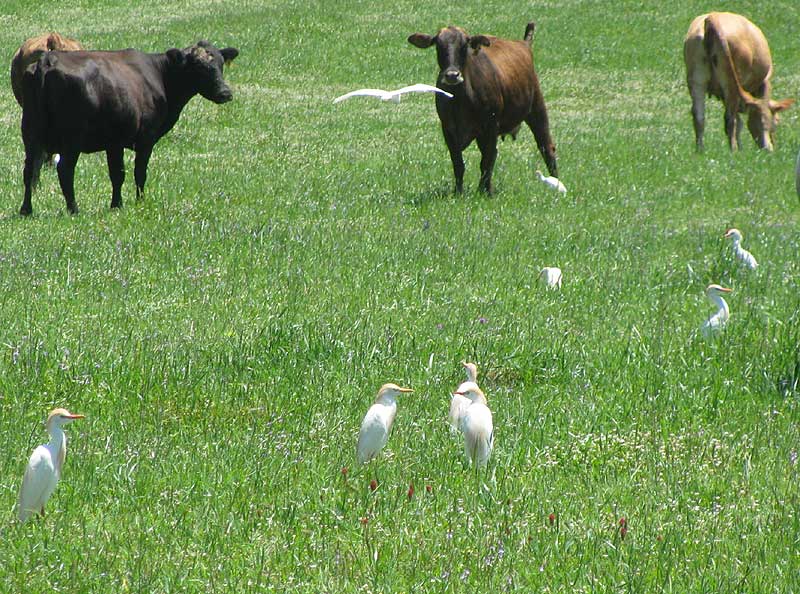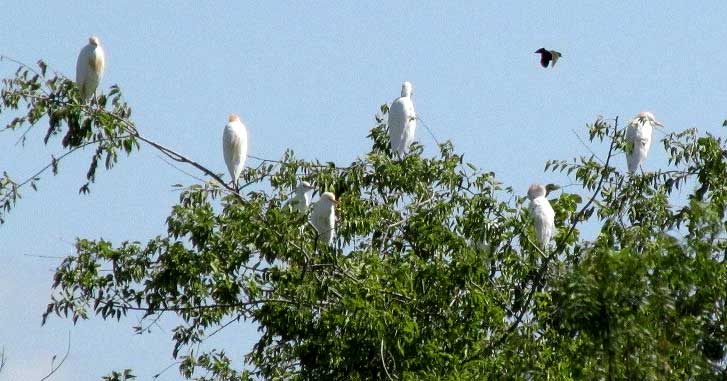Excerpts from Jim Conrad's
Naturalist Newsletter
from the January 5, 2009 Newsletter written at Mayan Beach Garden Inn on the Costa Maya, Quintana Roo, México
CATTLE EGRET
You see lots of white herons and egrets here but you always need to look closely to figure out which species you're seeing. Most sightings turn out to be Cattle Egrets, BUBULCUS IBIS, often seen on the sand road around water puddles stabbing at crabs and other critters. You can see one below:

Breeding Cattle Egrets show conspicuous tawny-buff patches on their crown, chest and back, but you can see that the one in the picture is pure white. Other all-white herons and egrets showing up here are the Great Egret, Snowy Egret, immature Little Blue Heron, and "white morphs" of the Reddish Egret and Great Blue Heron. You have to remember certain features of each to separate them.
For example, Snowy Egrets have yellow feet and immature Little Blue Herons have blue-gray beaks with dark tips, all unlike our Cattle Egret. The main features indicating that what's in they picture is a Cattle Egret are the yellow bill, black feet and, more than anything, the thick, stubby neck. Often, however -- as in the picture -- the bird has his neck scrooched down so you can't see how sinuous it is.
You can compare the above picture with one of an immature Little Blue Heron who often drops by here at http://www.backyardnature.net/n/09/090105cf.jpg.
This Little Blue Heron could almost be a Reddish Egret "white morph" but Reddish Egrets display shaggy heads and necks.
Why should so many herons and egrets be white, at least during part of their lives? One theory is that white birds are harder for prey in the water to see against the bright sky. Clay Green and Paul Leberg at the University of Louisiana tested this hypothesis with mosquitofish and crayfish and found that crayfish reacted the same to white and dark birds, but that mosquitofish actually avoided dark birds more than white.
So, who knows why so many herons and egrets are white?
from the April 29, 2012 Newsletter issued from the woods of the Loess Hill Region a few miles east of Natchez, Mississippi, USA
CATTLE EGRETS AMONG CATTLE
As in Mexico, around here if you pass by a pasture you're likely to see Cattle Egrets standing among or on the cows, as shown below:

Cattle Egrets in their breeding plumage, like the ones in the picture, can be distinguished from other white egrets and herons by the patches of light orange-brown on their crests and chests. Nonbreeding Cattle Egrets can be all white, and then their relatively thick, yellow beaks and thicker, shorter necks separate them from similar-sized, white herons and egrets found here, such as Snowy Egrets and juvenile Little Blue Herons.
I remember the first time Cattle Egrets were spotted in the rural part of western Kentucky where I grew up, possibly in 1963. Their appearance was so unusual that a farmer not particularly interested in Nature called my parents and said that a whole flock of big white birds had appeared in his pasture, and we went up to take a look. I was in college before I learned that they were Cattle Egrets, BUBULCUS IBIS.
My ornithology teacher told how the birds were undergoing one of the fastest and most widely ranging expansions of distribution ever seen among birds. Originally Cattle Egrets were native to southern Spain and Portugal, tropical and subtropical Africa and humid tropical and subtropical Asia. In the late 1800s they began expanding their range into southern Africa, and were first sighted in the Americas, on the boundary of Guiana and Suriname, in 1877, apparently having flown across the Atlantic Ocean. They didn't get permanently established there until the 1930s, though, but then they began expanding into much of the rest of the Americas, reaching western Kentucky around the early 60s. The species appears still to be expanding northward in western North America, but in the Northeast it seems to be in decline. Though they can turn up as far north as southern Canada, coast to coast, mostly they breed in the US Southeast.
The Wikipedia expert says that Cattle Egrets eat ticks and flies from cattle. They do that, but anyone who watches our birds awhile sees that mainly as the cattle move around they stir up creatures in the grass, which the egrets prey on. The cows' fresh manure also attracts flies for them.
from the August 31, 2014 Newsletter issued from the Frio Canyon Nature Education Center in the valley of the Dry Frio River in northern Uvalde County, southwestern Texas, on the southern border of the Edwards Plateau; elevation ~1750m (~5750 ft); N29.62°, W99.86°; USA
LOUNGING EGRETS
There's an end-of-summer feeling in the air, even here in southwestern Texas. In mid-afternoon the temperature can still reach 100° or more (38C) but it feels drier than during recent weeks, and if you keep quiet in the shade, it's pleasant enough.
For these last few months birds have been busy raising families, but now you see them slacking off, seeming more philosophical about things. Atop a Netleaf Hackberry tree on an island in one of several ponds in Cooks Slough Nature Park on Uvalde's south side, it was gratifying to see several white egrets or herons preening and gawking around. I didn't know which species they were until their picture appeared later on my laptop screen, and then it was clear that with such thick necks and blushes of rustiness on the napes and breasts of older birds, they were Cattle Egrets, as you can confirm below:

That silhouette in the background looks like it belongs to a Pterodactyl, but more likely it's a kingfisher.
Some of the Cattle Egrets in the picture are pure white, and these must be the young ones. In the picture, most adults with patches of rustiness are spaced out and busy preening, but the juveniles huddle together craning their necks looking around. There atop the hackberry tree on this hot morning when hectic road traffic rumbled across fields from a mile away and a police or Border Patrol helicopter circled the area these innocent, honest gestures pleased me more than I can say.
from the January 11, 2015 Newsletter issued from Río Lagartos, on the north-central coast of Yucatán, MÉXICO
CATTLE EGRETS & LOCUSTS
In extreme northeastern Yucatán State this week our truck passed through a small flight of them as late afternoon sunlight caught in their silvery wings, surrounding us with fluttering, drifting globes of radiance. There must have been more of them out in the savanna beside the road, for that's where a flock of Cattle Egrets was busily gobbling up what could be caught, the flock keeping up with the locusts' general southerly movement. Below, you can see some of the egrets at work:

Cattle Egrets are well known for this kind of behavior. Often they follow farmers' plows collecting earthworms. Though they favor insects, especially grasshoppers and other small arthropods, they also catch frogs, fish, lizards, small birds and rodents. In areas where people set grassland ablaze thinking it improves grass production, as here, Cattle Egrets follow along beside the fire, preying on small creatures trying to escape the flames.